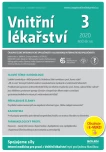Hepatorenal syndrome – update 2020
Authors:
Karolína Krátká; Pavla Libicherová; Nikola Mejzlíková; Ivan Rychlík
Authors‘ workplace:
I. interní klinika 3. LF UK a FN Královské Vinohrady, Praha
Published in:
Vnitř Lék 2020; 66(3): 71-75
Category:
Differential Diagnosis Column or What You Can Be Asked at a Postgraduate Certification Exam
Overview
Hepatorenal syndrome (HRS) is a serious complication in patients with advanced liver cirrhosis and ascites occurring simultaneously. According to current diagnostic criteria it is considered as one of the less common forms of acute kidney injury (AKI), referred to as HRS-AKI. As a result of the revision of the diagnostic criteria, there was a significant shift in the diagnosis of AKI in patients with liver cirrhosis, allowing early initiation of adequate measures and appropriate treatment. The following article describes the issue of AKI in liver cirrhosis in a wider context, the diagnostic criteria and algorithm of HRS-AKI treatment.
Keywords:
hepatorenal syndrome – liver cirrhosis – albumin – acute kidney injury – acute on chronic liver failure – terlipressin
Sources
1. Angeli P, Ginès P, Wong F, et al. Diagnosis and management of acute kidney injury in patients with cirrhosis: revised consensus recommendations of the International Club of Ascites. J Hepatol 2015; 62: 986–994.
2. Huelin P, Piano S, Solà E et al. Validation of a staging system for acute kidney injury in patients with cirrhosis and association with acute‑on‑chronic‑liver failure. Clin Gastroenterol Hepatol 2017; 15: 438–445.
3. Davenport A, Sheikh MF, Lamb E, et al. Acute kidney injury in acute‑on chronic liver failure: where does hepatorenal syndrome fit? Kidney International 2017; 92: 1058–1070.
4. Solé C, Pole E, Solà E, et al. Hepatorenal syndrome in the era of acute kidney injury. Liver International 2018; 25: 1–11.
5. Belcher JM, Garcia‑Tsao G, Sanyal AJ, et al. Association of AKI with mortality and compli‑ cations in hospitalized patients with cirrhosis. Hepatology 2013; 57: 753–762.
6. Fagundes C, Barreto R, Guevara M, et al. A modified acute kidney injury classification for diagnosis and risk stratification of impairment of kidney function in cirrhosis. J Hepatol 2013; 59: 474–481.
7. Bucsics T, Krones E. Renal dysfunction in cirrhosis: acute kidney injury and the hepatorenal syndrome. Gastroenterology Report 2017; 5: 127–137.
8. Krones E, Fickert P, Zitta S, et al. The chronic kidney disease epidemiology colloboration equation combining creatinine and cystatin C accurately assesses renal function in patients with cirrhosis. BMC Nephrol 2015; 16: 1–10.
9. Barreto R, Elia C, Solà E, et al. Urinary neutrophil gelatinase‑associated lipocalin predicts kidney outcome and death in patients with cirrhosis and bacterial infections. J Hepatol 2014; 61: 35–42.
10. Belcher JM, Sanyal AJ, Peixoto AJ, et al. Kidney biomarkers and differential diagnosis of patients with cirrhosis and acute kidney injury. Hepatology 2013; 57: 1–37.
11. Sola E, Kerbert AJ, Verspaget HW, et al. Plasma copeptin as biomarker of disease progression and prognosis in cirrhosis. J Hepatol 2016; 65: 914–920.
12. Kerbert AJ, Verbeke L, Chiang FW, et al. Copeptin as an Indicator of Hemodynamic Derangement and Prognosis in Liver Cirrhosis. PloS One 2015; 10: e0138264.
13. Adebayo D, Morabito V, Davenport A, et al. Renal dysfunction in cirrhosis is not just a vasomotor nephropathy. Kidney Int 2015; 87: 509–515.
14. Mandorfer M, Bota S, Schwabl P, et al. Nonselective beta blockers increase risk for hepatorenal syndrome and death in patients with cirrhosis and spontaneous bacterial peritonitis. Gastroenterology 2014; 146: 1680–1690.
15. Theocharidou E, Krag A, Bendtsen F, et al. Cardiac dysfunction in cirrhosis – does adrenal function play a role? A hypothesis. Liver Int 2012; 32: 1327–1332.
16. Weichselbaum L, Gustot T. The Organs in Acute‑on‑Chronic Liver Failure. Semin Liver Dis 2016; 36: 174–180.
17. Shah N, Mohamed PE, Jover‑cobos M et al. Increased renal expression and urinary excretion of TLR4 in acute kidney injury associated with cirrhosis. Liver Int 2013; 33: 398–409.
18. Gustot T, Durand F, Lebrec D, et al. Severe sepsis in cirrhosis. Hepatology 2009; 50: 2022–2033.
19. Bernardi M, Caraceni P, Navickis RJ, et al. Albumin infusion in patients undergoing large‑volume paracentesis: a meta‑analysis of randomized trials. Hepatology 2012; 55: 1172–1181.
20. European Association for the Study of the Liver. EASL Clinical Practice Guidelines for the management of patients with decompensated cirrhosis. J Hepatol 2018; 69: 406–460.
21. Bernardi M, Ricci CS, Zaccherini G. Role of human albumin in the management of complications of liver cirrhosis. J Clin Exp Hepatol 2014; 4: 302–311.
22. Afinogenova Y, Tapper EB. The efficacy and safety profile of albumin administration for patients with cirrhosis at high risk of hepatorenal syndrome is dose dependent. Gastroenterol Rep (Oxf) 2015; 3: 216–221.
23. Salerno F. Albumin treatment regimen for type 1 hepatorenal syndrome: a dose‑response meta‑analysis. BMC Gastroenterol 2015; 55: 1–11.
24. Cavallin M, Piano S, Romano A, et al. Terlipressin given by continuous intravenous infusion versus intravenous boluses in the treatment of hepatorenal syndrome: a randomized controlled study. Hepatology 2016; 63: 983–992.
25. Singh V, Ghosh S, Singh B, et al. Noradrenaline vs. terlipressin in the treatment of hepatorenal syndrome: a randomized study. J Hepatol 2012; 56: 1293–1298.
26. Cavallin M, Kamath PS, Merli M, et al. Terlipressin plus albumin versus midodrine and octreotide plus albumin in the treatment of hepatorenal syndrome: A randomized trial. Hepatology 2015; 62: 567–574.
27. European Association for the Study of the Liver. EASL clinical practise guidelines on the management of ascites, spontaneous bacterial peritonitis, and hepatorenal syndrome in cirrhosis. J Hepatol 2010; 53: 397–417.
Labels
Diabetology Endocrinology Internal medicineArticle was published in
Internal Medicine

2020 Issue 3
Most read in this issue
- Local thrombolysis for deep vein thrombosis: why, for whom and how?
- What is hiden behind autoinflammation?
- Proteinuria from an internist‘s point of view
- Hepatorenal syndrome – update 2020
